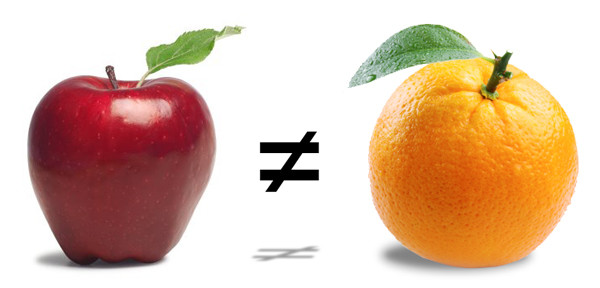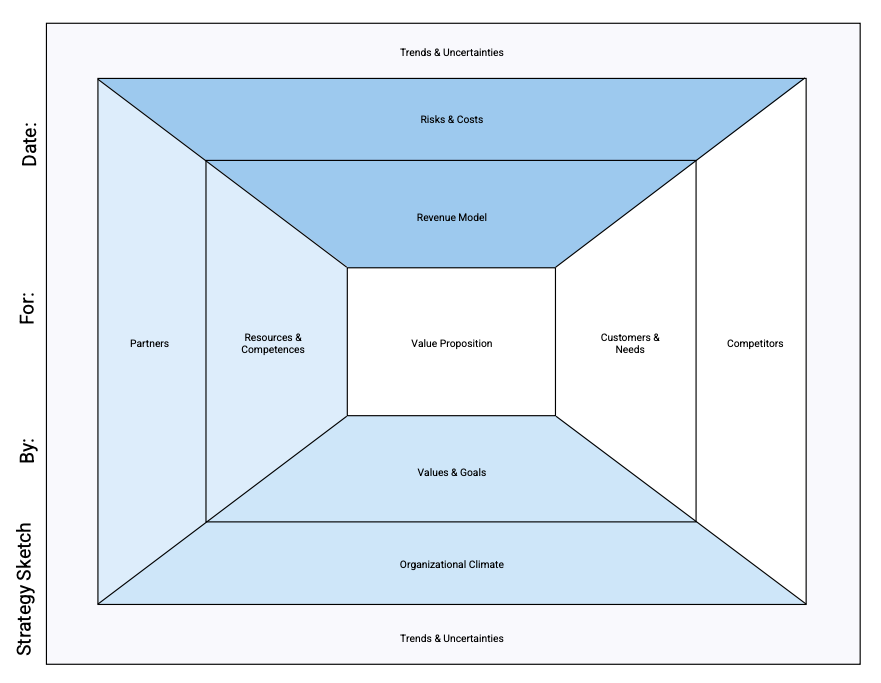
Updating the Business Model Canvas: “The Strategy Sketch”
We are in a period of extreme acceleration, disruption, and uncertainty. That, of course,
creates new problems, business problems that our old business tools are not equipped to deal with. From Porter’s
5 forces to SWOT Analyses, to PESTLE analyses, these tools have been useful and helpful in their own way, but I
(and several others) have encountered several issues while working with these tools.
This also applies to one of the widely used business tool today, the Business Model Canvas. While a great addition to
the strategy toolbox, it also has its drawbacks. Knowing these drawbacks is important for anyone using this tool.
And for me, these drawbacks where the reason ten years ago to develop a more complete and updated alternative for the
Business Model Canvas: the Strategy Sketch.
Benefits of the Business Model Canvas
The defining feature and main benefit of the Business Model Canvas is the fact that it contains the key elements
of a business model on a single sheet of paper. This simple fact makes it a powerful tool to analyze, discuss
and redesign the business model of a company. It gives you have one single tool which tells you exactly what
to pay attention to.
The power of this ‘canvas’ idea can hardly be overestimated. Not surprisingly, ever since its introduction,
numerous other ‘canvasses’ have been proposed by others, for virtually every imaginable aspect of business.
But what makes it so compelling? The following three benefits stand out:
- It creates an immediate and shared understanding of what a business model is. Rather than discussing about definitions, the Business Model Canvas creates a shared and visual language that everyone can understand by simply showing what’s inside.
- It is very versatile and can be used for analyzing and mapping a company’s current business model as well as redesigning it or designing an entirely new business model from scratch.
- It fits the well-known “brown paper and post-it” sessions format that most people in business are already used to—including their digital alternatives.
Drawbacks of the Business Model Canvas
When using the Business Model Canvas in my coaching and training with startups and mature firms, I experienced that
some key elements seemed to be missing in the framework. Especially “competition” was such element. Even though
it is discussed at quite some length in Osterwalder & Pigneur's inspiring book, I observed that because this
element was missing, it received less attention than it should have. This is quite common for all frameworks:
anything that is missing runs the risk of escaping our attention. This made me think whether something should
be added to the Business Model Canvas.
I also couldn't come to grips with the contents of the Business Model Canvas when I compared it to the contents
of an average strategy textbook and to the strategy literature more broadly. Elements that were prominent in the
strategy literature - such as values and goals - are missing in the Business Model Canvas as well as the Business
Model Generation book in which it is introduced. Such missing elements made me think whether a separate framework
needed to be developed for strategy next to the Business Model Canvas.
Additionally, while using the Business Model Canvas, it turned out that some elements were often left blank or
only contained quite trivial or operational content. This applied mostly to the “Customer relationships” and
“Channels” elements. Furthermore, when using the Business Model Canvas, the contents of the “Key Activities”
element seemed more related to how to execute or implement a business model rather than that it was part of the
business model itself. Also this triggered me to try and develop an alternative framework.
So, whereas the main idea of the Business Model Canvas—outlining the components of a business model visually on
a single sheet—remains great, it turns out to be rather incomplete and unbalanced with respect to its coverage
of what to pay attention to in strategy.
The Strategy Sketch as an upgrade of the Business Model Canvas
What I tried to do is develop a strategy framework that is as complete and simple as possible. My aim was to develop a framework that was significantly more complete than the Business Model Canvas in its coverage of strategy elements without making it more complex. At the end, and after about six versions, this resulted in the Strategy Sketch. With ten elements, it has just one element more than the Business Model Canvas. So in terms of simplicity the two are more or less equal in this respect. In terms of content and completeness, however, the two are quite different. To show how, l will discuss the main similarities, modifications, additions and deletions of elements.

Similarities
- Value proposition: In both frameworks this is the central element. It represents the value an organization creates through its products and/or services. From the descriptions of what a value proposition is, I have omitted a reference to customer needs to indicate that what an organization offers (its value proposition) can be quite different from what its customers need. Besides this different nuance, the two elements are largely the same. As will appear in the "Deletions" section below, though, the notion of a value proposition in the Strategy Sketch is more inclusive than in the Business Model Canvas.
- Customers & needs (customer segments): Included in both frameworks and representing the customers and their needs. By using the word "needs" instead of "segments" I wanted to stress that it is particular the customer needs that are important. And by replacing the word "segment" I wanted to reduce the connection that one might immediately make to the classical STP marketing paradigm of segmenting-targeting-positioning. For the rest, though, these two elements mean mostly the same.
- Partners (key partners): In both frameworks, this element refers to the organizations and individuals an organization is working with. Besides the word "key" there is no difference here. I don't use the word "key" because it applies to all ten elements of the Strategy Sketch. Strategy is about focusing on those things that are most important. This means that it is also the key value propositions, key customer needs, ey revenue model, etc. that one focuses on. Rather than using the word "key" for just some elements, I omitted it altogether.
- Revenue model (revenue streams): In both framework this refers basically to how money is made; to who is paying how, when and for what. Both frameworks are open to mention multiple revenue streams here, including non-financial ones such as paying with data. There are no important differences here between the two frameworks.
Modifications
While the above four elements only contain minor tweaks of these four elements of the Business Model Canvas, two elements have been modified in a more substantial way:
- Resources & competences (Key resources and key activities): Here I have combined the two elements of the Business Model Canvas "Key Resources" and "Key Activities" into a single element that reflects an organization's means. The reason is that the two are hardly discernible, especially in the case of intangible resources. What one has (a resource) and what one can do (a competence) is closely related. I used the terms resources and competencies to stay close to the terminology used in the strategy literature. I might have used capabilities instead of competencies but by using the term competencies I wanted to pay tribute to the work on core competencies.
- Risks & costs (Cost structure): As the terminology immediately reveals, the main difference between these two elements is that the Risks & Costs element of the Strategy Sketch explicitly pays attention to risks next to costs. Risks and costs are both types of expenses. The difference is that the likelihood and magnitude of costs can usually be calculated, while those of of risks are less predictable. By paying explicit attention to risks, the Strategy Sketch goes beyond the Business Model Canvas's focus on just costs. Especially in strategy this is important.
Additions
The Strategy Sketch includes four elements that are not included in the Business Model Canvas. I already referred to most of them above when explaining what has triggered me to develop the Strategy Sketch:
- Competitors: The main reason for including this element is that any value an organization creates for its customers is always relative to the available alternatives. Customers will always compare an offering to some alternative. So, as part of a strategy, one needs to spell out these alternatives. It is quite popular today - e.g. in the business model literature and in "Blue Ocean Strategy" - to suggest that competition could or even should be ignored. While it may have been overemphasized in traditional strategy, omitting it from a strategy framework is a serious loss. Any organization needs good competitors to create a market together and to position oneself against. Therefore, in combination with the fact that anything that is not in a framework easily escapes our attention, competition was added as element to the Strategy Sketch.
- Values & goals: The implicit assumption of the business model canvas is that the key purpose is making money. Of course that may be important, but other values and goals play a crucial role as well in guiding an organization. Also this may have been overemphasized in traditional strategy approaches with the weight they put on mission and vision statements, key values, goal setting and objectives. But even if these are not always the universal starting point of a strategy, they have a profound influence on any choice that is made in the other elements of strategy. Therefore, a strategy framework is incomplete without an element representing an organization's values and goals.
- Organizational climate: This element reflects the overall culture and structure of an organization. As such, it may look the least 'strategic' of all elements. Yet, also this element is essential when talking about strategy. Next to an organization's specific resources and competencies, organizational climate reflects more generally how an organization works and what is characteristic for it. This is important to take into account because it largely determines what an organization can achieve and what not. An organization that is, for example, growth-oriented, flexible and innovative will have a different approach to customers, partners, risks, etc. than an organization that is rigid and conservative.
- Trends & uncertainties: This was the last element that was added to the Strategy Sketch and it reflects the external environment, or context in which an organization operates. Rather than the conventional "opportunities" and "threats" of the well-known SWOT framework, I chose trends and uncertainties. The main reason is that what is an opportunity and what is a threat is largely arbitrary, dependent on the competition, and on the kind of response that one can come up with. Used also in scenario-planning, the distinction between trends and uncertainties is more robust. Even though the Business Model Generation book includes external environment it in the process, making it part of the framework itself was important to have one single framework that makes sure we don't forget anything important when analysing, discussing, generating or managing strategy.
Deletions
To make the Strategy Sketch not more complex than needed, I also looked whether elements of the Business Model Canvas could be deleted without losing much. It turned out that two, or actually three, elements could be dropped.
- Customer relationships: Of course the kind of relationship one has with one's customers is important. It matters a great deal, for example whether they are just seen as transactional buyers, or whether a long-term co-creative relationship is developed with them. However, if this is an important way to distinguish an organization from its competitors, the customer relationship is actually part of the value proposition. So, in the Strategy Sketch, the value proposition is not just about the 'job to be done' and the 'pains' and 'gains' one offers, but also about the kind of relationship one establishes with the customer.
- Channels: Something similar applies to channels. They are important. However, they are either part of the value proposition (e.g. in the case of a webshop the channel is an integral part of the value proposition itself), or already covered in the 'Partners' element (e.g. in the case of selling through distributors, they are important partners), or they reflect an operational choice that follows later on in the process (e.g. in the case of deciding which social media channels to use to reach the customer). For these reasons, I found it not necessary to reserve a separate element for channels.
- Key activities: I already referred to this element when discussing the Resources & Competences element of the Strategy Sketch. The reason for mentioning it here again is that I've always been a bit puzzled about this element of the Business Model Canvas. On the one hand it reflects the key competences of an organization. On the other hand, it also seems to reflect all activities that are needed to realize the business model. It is along the first interpretation that I merged them with resources into a single element. Along the second interpretation I deleted them, since such activities relate more to the execution or implementation of a strategy: making changes along any of the elements aks for certain activities to be performed.
I hope these explanations help understanding and appreciating the key differences between the Business Model Canvas and the Strategy Sketch. This is not a matter of one framework being better or worse than another framework. They are different, serve different purposes, and may appeal to different audiences. The Business Model Canvas serves designing a business model and may be preferred to think in some detail about what products and services one wants to offer and how to get them to the customer.
The Strategy Sketch serves making strategy and may be preferred when setting a new direction for an organization, developing new business, or modifying an existing line of business.
What organizational structure is effective? Use The Organizational Map
January 5, 2021 — 6 minute read
The organizational map helps you get an overall idea of the quality of your organization.
It also helps you identify where are its weakest points—and thus, where to start with making improvements.
Read article

The organizational map helps you get an overall idea of the quality of your organization. It also helps you identify where are its weakest points—and thus, where to start with making improvements.
Read article
A nine-step approach for effective leadership during (and after) crisis
These steps are mostly targeted at creating long-term structural changes in your mindset and behavior. However, they can also be applied to keep your cool in a crisis like the current crisis.
Read article

I am Jeroen Kraaijenbrink and I have been consulting and mentoring CEOs and leaders in strategy affairs for over 10 years.
With my 20+ years venture as an academic in strategy and management theory, I've written several articles to improve your strategy,
management and organization.

I write articles bi-weekly on my newsletter.
Learn about relevant industry knowledge and strategy and leadership developments by subscribing to my newsletter.

